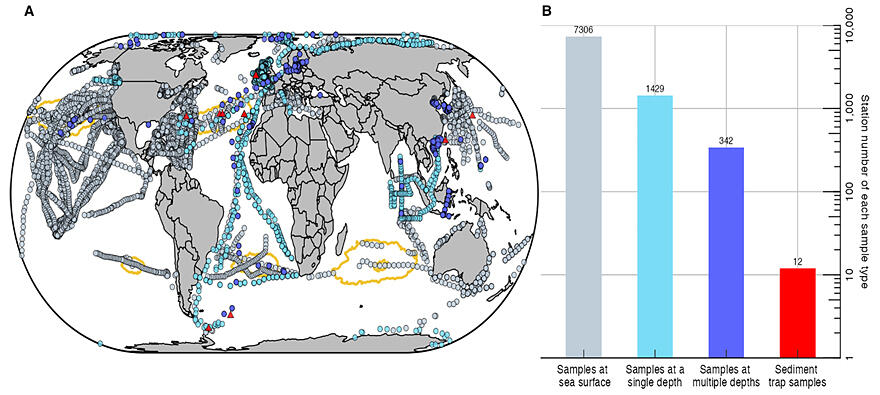Researcher Shiye Zhao and Group Leader Ryota Nakajima from the Marine Biodiversity and Environmental Assessment Research Center (BioEnv), Research Institute for Global Change, Japan Agency for Marine-Earth Science and Technology (JAMSTEC) and their research group have revealed the global distribution patterns of microplastics (MPs) in the ocean water layer (water column) from the surface to the seafloor. The study found that MPs are highly concentrated and widely distributed throughout the entire water column, with concentrations significantly higher in coastal areas compared with offshore regions. This research is expected to help estimate the risks of MPs to marine ecosystems. The group's findings were published in the international academic journal Nature on April 30.

Provided by JAMSTEC
An estimated 9-14 million tons of plastics flow into the ocean from the land each year. Most do not biodegrade, causing plastic waste to accumulate in marine environments. Many marine organisms mistake MPs for food, and the harmful chemicals in MPs can adversely affect the entire food chain. The ocean plays a crucial role in transporting carbon dioxide to the deep sea and sequestering carbon long-term (biological carbon pump), but MPs may potentially interfere with this process.
Previously, JAMSTEC demonstrated that MPs do not remain solely on the sea surface— some sink due to differences in shape, size, and density, ultimately reaching the seafloor. Last year, the organization reported detecting large amounts of MPs at depths ranging from 10 to 5,500 meters in a survey of the subtropical gyres of the Pacific and Atlantic Oceans. However, investigations of MPs drifting vertically through the "water column" from the sea surface to the seafloor have been limited, with the actual situation largely unknown.
While floating MPs at the sea surface have been collected at approximately 7,000 locations worldwide, water column MPs have been sampled at only 1,400 single depths, with only around 340 locations examining MPs across multiple depths at a single observation point.
In this study, the researchers integrated and reanalyzed depth profile data of water column MPs from 1,885 locations collected by research teams worldwide between 2014 and 2024. They examined the global pollution levels, distribution patterns, and potential transport mechanisms of MPs in the ocean water column.
The results revealed that MPs are highly concentrated and widely distributed at all water depths, with the water column serving as a crucial accumulation site for MPs. The median MP concentration was 205 particles per cubic meter. Sinking patterns differed by particle size. Small MPs (1-100 micrometers) showed a gradual decrease in concentration with depth and tended to be uniformly distributed throughout the water column. Large MPs (100-5,000 micrometers) tended to remain at the surface or rapidly sink to the seafloor.
MP concentrations were particularly high near coastal plastic sources, with a median of 500 particles per cubic meter - 30 times higher than offshore values. Although MP concentrations decreased with water depth, the rate of decrease varied significantly by region. In coastal areas, concentrations dropped up to 1,000-fold from the surface to the seafloor, reflecting vertical transport by the biological pump.
The study also found that carbon derived from MPs in the water column represents a non-negligible proportion of naturally occurring particulate organic carbon (POC) in seawater. MP-derived carbon accounted for an average of 1.1% of total POC in the water column and a maximum of 5% at depths of 2,000 meters.
The proportion of plastic-derived carbon in POC is expected to increase in the future, potentially causing serious impacts on carbon sequestration and biogeochemical cycles over hundreds to thousands of years.
Moving forward, standardized survey methods and high-resolution observation data collection for water column MPs are needed.
Zhao commented: "I lead an international team of scientists from Japan, the United States, the Netherlands, Italy, and New Zealand in collecting water column microplastics worldwide. Our goal is to create a high-quality dataset of microplastics in the global ocean using unified methods. This data is crucial for comprehensively understanding the long-term impacts of plastic pollution on marine ecosystems and global biogeochemical cycles."
Journal Information
Publication: Nature
Title: The distribution of subsurface microplastics in the ocean
DOI: 10.1038/s41586-025-08818-1
This article has been translated by JST with permission from The Science News Ltd. (https://sci-news.co.jp/). Unauthorized reproduction of the article and photographs is prohibited.




